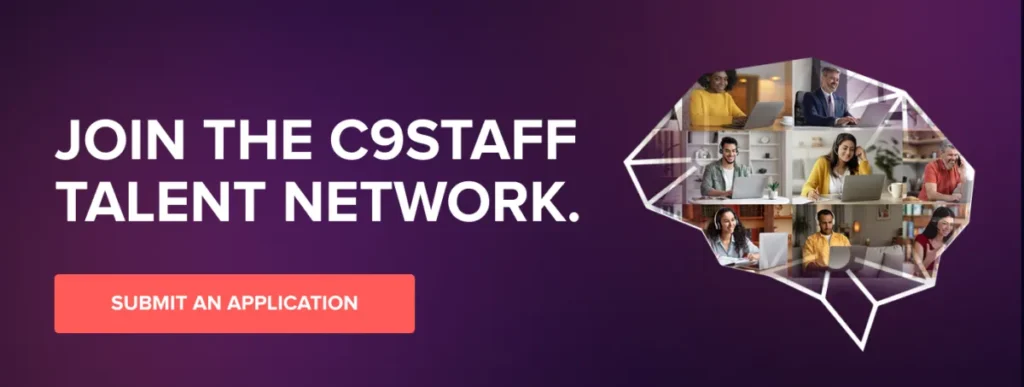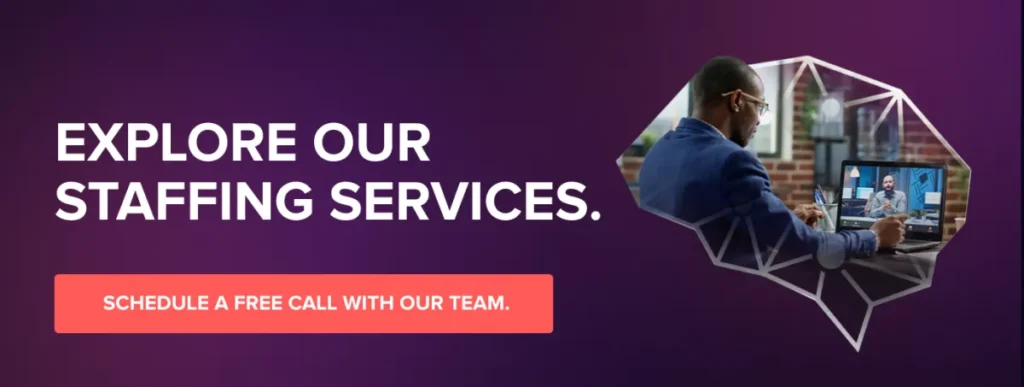Introduction

In the last decade, the demand for software developers has skyrocketed, with the Bureau of Labor Statistics projecting a 22% growth from 2020 to 2030, much faster than the average for all occupations. This explosive growth highlights the critical need for precise and effective job descriptions to ensure the right talents are harnessed. As the tech industry evolves, the clarity of a job description can significantly impact the quality of applicants and the success of talent acquisition.
If your goal is to secure the best possible job description template to streamline your hiring process, look no further. Click the link below to download our complimentary Software Developer Job Description template. Crafted with precision, this template embodies the core principles and best practices of C9Staff’s renowned hiring methodology. It’s designed to provide you with a solid foundation for drafting your own specifications, ensuring you attract top-tier talent effectively and efficiently
Software Developer Job Description Template

Understanding the intricacies of a software developer job description is crucial, not just for candidates seeking to find their fit but also for employers aiming to attract top-tier talent. For job seekers, a well-crafted job description serves as a map, guiding them through the necessary skills and experiences required, and helps them assess their own qualifications against the role expectations. On the flip side, employers benefit immensely from detailed descriptions as they set clear expectations, attract qualified applicants, and reduce the time spent sifting through unsuitable candidates.
This article is designed to serve a dual purpose. For you, the job seeker, it aims to demystify the elements of a job description, helping you to discern key details that indicate a role’s suitability and expectations. For you, the employer, it provides insights into crafting clear, inclusive, and appealing job descriptions that stand out in a competitive job market. By the end of this guide, you will be equipped with the knowledge to either tailor your applications more strategically or enhance your recruitment process. Dive in to ensure you’re not only keeping pace with the industry standards but setting new benchmarks in the tech world.
A software developer plays a pivotal role in today’s tech-driven world, where they translate software requirements into actionable programming code and maintain the foundation of virtually any business that leverages technology. At its core, a software developer’s responsibilities include designing, testing, deploying, and maintaining software systems. They work daily on tasks ranging from small bug fixes and enhancements to the development of large, complex systems.
Understanding the Role of a Software Developer

The nature of a software developer’s role can vary significantly depending on several factors:
- Industry: In finance, a developer might focus on building high-frequency trading platforms, while in healthcare, they might develop systems to manage patient records securely and efficiently.
- Company Size: Developers in startups often wear multiple hats, possibly working on both front-end and back-end systems, whereas those in larger corporations might specialize in a narrow aspect of software development, such as database management.
- Technology Stack: The tools and platforms developers use can range widely; for instance, mobile developers might specialize in iOS or Android platforms, while others might work on web development with specific frameworks like React or Angular.
Essential Skills and Competencies:
- Technical Skills: Proficiency in programming languages such as Java, Python, or JavaScript is fundamental. Familiarity with frameworks and environments like .NET, Spring, or Node.js is also crucial.
- Soft Skills: Beyond technical ability, successful developers must exhibit strong problem-solving capabilities, effective communication skills, and teamwork. They must be able to think logically and interact well with non-technical team members.
Recent Trends Impacting the Role:
- Remote Work: The shift towards remote work has not only changed where developers work but also how they collaborate and communicate.
- Data Security: As cyber threats evolve, developers need to prioritize secure coding practices to protect data integrity and privacy.
- Agile Methodologies: The rapid adoption of agile methodologies requires developers to be more adaptable and collaborative than ever.
As you navigate your career path or refine your hiring practices, consider how these trends might influence your approach to software development. Whether you’re adapting to remote teams or integrating new security measures into your projects, staying ahead of these trends will be crucial. By understanding the broader scope and the dynamic nature of the role, you can better position yourself or your team for success in this ever-evolving landscape.
Future-Proofing Tech: How Software Development Will Transform in 2024
For Candidates - How to Interpret Software Developer Job Descriptions

You’ve boarded on your journey to find the perfect software development role, navigating through a vast ocean of job descriptions that range from the vague to the overly detailed. It’s crucial to cut through the clutter and zero in on what really matters. This guide is designed to help you, a skilled developer, interpret job descriptions effectively so you can make informed decisions about your career trajectory.
Identifying Key Elements in Job Descriptions
- Job Title and Career Level: First, assess whether the job title and the associated career level (junior, mid-level, senior) align with your skills and career aspirations. This can give you immediate insight into the expectations and responsibilities that come with the role.
- Technologies and Tools: Pay close attention to the technologies listed. Are they modern and widely used in the industry, or are they outdated? The tools and languages you will work with can significantly impact your professional development and job satisfaction.
- Essential Responsibilities: Look for a clear outline of what your day-to-day duties will entail. This helps you gauge whether the role suits your expertise and career goals.
- Professional Development: Opportunities for growth such as training programs, certifications, and attending conferences are indicators of an employer invested in their team’s growth.
Distinguishing ‘Must-Have’ Skills from ‘Nice-to-Have’ Skills
Must-Haves: These are the non-negotiables. If the job description specifies certain qualifications or skills as essential, ensure you meet these criteria. These are often prerequisites for even being considered for the role.
Nice-to-Haves: These qualifications are beneficial but not critical. They can often give you an edge over other candidates but aren’t deal-breakers if you lack them. Use these to gauge how well-rounded the role is and how you might exceed expectations.
Evaluating Company Culture
- Mission and Values: Can you find information about the company’s mission and values? These often indicate the core philosophies of the business and whether they resonate with your own professional values.
- Tone of the Job Description: The way a job description is written can also provide clues about the company culture. A conversational and informal tone could suggest a more relaxed workplace, whereas a formal and concise description might indicate a more traditional corporate environment.
- Benefits and Perks: Benefits such as remote work, flexible hours, health insurance, and vacation policies can reflect how the company treats its employees. More generous benefits often suggest a company that cares about the well-being and balance in its employees’ lives.
- Employee Reviews: Websites like Glassdoor can be invaluable for getting a sense of the internal culture from current and past employees’ perspectives.
By equipping yourself with these analytical tools, you’re not just searching for any job—you’re pinpointing the one that fits your professional needs and personal values. Use this guide to steer through the complexities of job descriptions and towards a role that promises growth, satisfaction, and stability. Remember, the right job is out there—you just need to know how to find it.
Are you ready to supercharge your career and land your dream job? C9Staff is here to help you navigate the path to new and exciting opportunities. Submit your resume to our talent acquisition department by clicking the link below. If your qualifications align with our client requirements, we’ll be in touch to discuss potential opportunities that match your skills and aspirations. Don’t miss the chance to elevate your career—connect with us today and let us help you find the perfect job that aligns with your professional goals.

2024 Software Development Essentials: Your Comprehensive Learning Path with Simplilearn
For Employers - Writing Effective Software Developer Job Descriptions

You’re at the helm of hiring at your tech company, tasked with the crucial role of drafting job descriptions that not only detail the needs of the position but also draw in a broad spectrum of skilled applicants. Here’s how you can craft job descriptions that are both effective and inclusive, ensuring your postings resonate with top talent and stand out in today’s competitive job market.
Understanding the Importance of a Clear Job Description
Begin by recognizing the power of clarity in job descriptions. A well-written job description serves as the primary bridge between your company and potential candidates. It should effectively communicate not just the responsibilities and requirements of the role but also the culture and ethos of your organization. This clarity not only helps in attracting suitable applicants but also in deterring unqualified ones, saving you time and resources in the recruitment process.
Components of a Great Job Description
- Job Title: Start with a precise job title that reflects the role’s level and specialization. Avoid jargon and overly creative titles that might confuse job seekers.
- Summary: Provide a succinct overview that highlights the role’s significance within the company. This should give candidates a clear idea of where they’ll fit in and how they can impact.
- Duties: List the key responsibilities in clear, concise bullets. Be specific about what the day-to-day activities will entail to give candidates a realistic preview of their potential job.
- Qualifications: Clearly differentiate between required skills and those that are preferred. Make sure to include both technical competencies, such as specific programming languages or frameworks, and soft skills like teamwork and communication.
- Benefits and Company Culture: Illustrate the benefits and perks that differentiate your company from others. Include aspects of company culture and values to appeal to candidates who are looking not just for a job, but for a place where they can belong and grow.
Promoting Diversity Through Inclusive Language
Inclusive language in job descriptions is key to attracting a diverse range of candidates. Avoid gender-coded words like “rockstar” or “ninja,” which can deter women and non-binary individuals from applying. Use terms that encourage diverse applicants to feel that they are welcome and valued, regardless of their background.
SEO Tips for Job Descriptions
To ensure your job description is seen by the right candidates, optimize it for search engines:
- Keywords: Incorporate relevant keywords that potential candidates are likely to use when searching for job opportunities. These include skills, tools, and the job title itself.
- Localization: If the role is location-specific, include geographical keywords that prospective applicants might search for.
- Mobile Optimization: Ensure that the job description is easily readable on mobile devices, as many job seekers use their phones to find and apply for jobs.
By meticulously crafting each part of the job description and employing strategic SEO practices, you not only enhance the visibility of your postings but also ensure that they reach and resonate with a diverse pool of talent. Remember, the effort you put into creating detailed and inclusive job descriptions reflects your company’s dedication to finding and nurturing the right talent. Engage directly with potential applicants through your words, making each candidate feel seen and valued from the very first interaction.
If your goal is to secure the best possible job description template to streamline your hiring process, look no further. Click the link below to download our complimentary Software Developer Job Description template. Crafted with precision, this template embodies the core principles and best practices of C9Staff’s renowned hiring methodology. It’s designed to provide you with a solid foundation for drafting your own specifications, ensuring you attract top-tier talent effectively and efficiently
Software Developer Job Description Template

Common Mistakes in Job Descriptions

You’ve been shaping hiring strategies long enough to see the patterns – and the problems. As you aim to refine your company’s recruitment efforts, you recognize that the efficacy of attracting top talent often hinges on the clarity and accuracy of your job descriptions. This guide will help you navigate common pitfalls that could be costing you ideal candidates, ensuring that your job postings attract the skilled professionals your company needs.
Avoiding Overly Broad or Vague Descriptions
The Challenge: A job description that reads like a one-size-fits-all can be as ineffective as one that is too narrow. When potential candidates can’t discern the specific expectations and responsibilities of a role, they may either pass over the opportunity or apply in hopes that details will become clearer later on.
The Solution: Specify the role’s day-to-day tasks and how they contribute to the organization’s objectives. Use clear, concise language and avoid industry jargon that might confuse or exclude qualified candidates. This will help candidates assess their fit for the position and envision their future at your company.
Updating Skills and Requirements
The Challenge: Job descriptions that list outdated technologies or irrelevant qualifications can alienate top talent who are proficient in current and emerging tools. Sticking to old standards not only limits your pool of applicants but may also suggest that your company is behind the curve technologically.
The Solution: Regularly review and update the skills and technologies listed in your job descriptions. Engage with your IT department or consult industry standards to ensure you’re asking for relevant qualifications that reflect modern practices. This shows candidates that your company remains at the cutting edge and values continuous improvement.
Clarifying Remote or Hybrid Work Options
The Challenge: In today’s job market, flexibility is not just appreciated but expected by many professionals. A lack of clear information regarding remote or hybrid work options can make your job less appealing or lead to misunderstandings after hiring.
The Solution: Be explicit about the work environment in your job postings. If the position is remote, specify whether this is fully remote or if there are expectations for occasional office visits. For hybrid roles, clearly outline how many days are expected in-office and the location. This transparency helps manage expectations and attracts candidates who are comfortable with your working arrangements.
Real-World Examples
You are about to embark on a crucial journey through the nuances of software developer job descriptions. Your mission is to dissect and understand what differentiates a well-written job description from a poorly crafted one. This analysis will help illuminate the do’s and don’ts for employers and provide valuable insights for candidates.
- Selection of Job Descriptions
Start by selecting two distinct job descriptions from the tech industry. The first should be a poorly written example that exemplifies common errors, such as vagueness or outdated requirements. The second should represent a model of clarity, specificity, and modern relevance. These examples will serve as the foundation for your detailed comparative analysis.
- Analysis of an Ineffective Job Description:
Begin with the poorly crafted job description. Highlight specific elements that detract from its effectiveness:
- Vagueness in Responsibilities: Point out any broad or unclearly defined tasks that could confuse potential candidates about their daily duties.
- Outdated or Irrelevant Skills: Identify mentions of technologies or methodologies that are no longer industry-standard, which could mislead or deter savvy job seekers.
- Lack of Engagement: Critique the tone and language used. Is it engaging and inviting to a wide range of candidates, or does it read like a checklist with little thought to reader engagement?
- Analysis of an Effective Job Description:
Shift your focus to the well-written example. Discuss the elements that contribute to its success:
- Clarity and Precision in Role Definition: Emphasize how the job title and responsibilities are clearly defined, giving candidates a precise understanding of what the job entails.
- Modern and Relevant Skills: Highlight how the description specifies current technologies and skills, reflecting the company’s commitment to staying at the forefront of the industry.
- Inclusive and Welcoming Language: Note any language that broadens the appeal of the position, inviting diverse applicants to feel valued and encouraged to apply.
- Integrating Expert Insights:
To deepen your analysis, incorporate quotes or insights from HR professionals and seasoned software developers. These experts can provide commentary on why certain elements of a job description resonate well with candidates or fail to do so. For instance, an HR professional might explain the importance of using inclusive language to attract a broader pool of talents, while a developer could discuss the appeal of a job description that clearly outlines growth opportunities and technology stacks.
If you’re looking to enhance your recruitment strategy and find the perfect software developer for your team, we invite you to discover how C9Staff can assist in sourcing, recruiting, hiring, training, managing, and deploying the ideal candidate for your organization. Schedule a complimentary exploratory call with one of our account managers today. During this call, we’ll carefully listen to your needs and recommend potential candidates at no cost, helping you evaluate the best talent available at competitive prices. Take the first step towards optimizing your recruitment process and ensuring you secure top-tier talent tailored to your specific needs.

Conclusion

As we draw this guide to a close, let’s consolidate the insights we’ve explored about the nuanced world of software developer job descriptions. Whether you’re an employer striving to attract top-tier talent, or a job seeker navigating through myriad opportunities, the significance of a well-crafted job description cannot be overstated. For both parties, these descriptions are not just informational; they are the initial handshake, the first point of cultural fit, and a reflection of mutual expectations.
For Employers: You’ve learned that clarity, precision, and inclusivity in your job descriptions not only heighten the appeal of your openings but also ensure that you attract the right candidates. The way you present a job can either captivate or alienate potential talent. By employing inclusive language, detailing current and relevant skills, and articulating clear work environment options, you set a foundation that appeals to a diverse, skilled audience. Now is the time to revisit your job descriptions, refine them, and make them resonate with the ethos of the candidates you wish to attract.
For Candidates: As you sift through various job offers, use the insights from this guide to identify the markers of a well-thought-out job description. These details can signal a company’s legitimacy and commitment to its employees. Scrutinize job descriptions not just for what they say but for what they imply about the company culture, growth opportunities, and the team you will potentially join.
Don’t let these insights idle. Employers, take a moment to review your current job postings—are they clear, precise, and inclusive? Do they reflect the cutting-edge nature of your projects and the values of your company? Candidates, approach your job search with a critical eye—look beyond the surface and read between the lines to truly understand where an opportunity might lead you.
As the tech industry continues to evolve at a breakneck pace, ask yourself, “Am I prepared to adapt to the changing demands of the software development landscape?” Whether you’re hiring or hoping to get hired, stay proactive about learning, adaptability, and alignment with industry standards.
By embracing these principles, you ensure that your career or your company remains resilient, relevant, and ready for the future of tech. Together, let’s step forward into a world where job descriptions are not just notices, but bridges to greater opportunities and deeper understanding.




